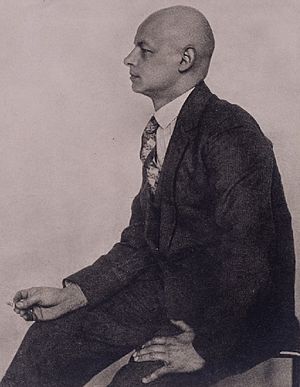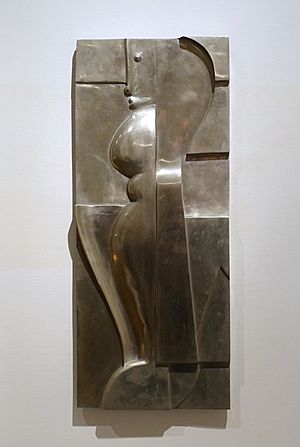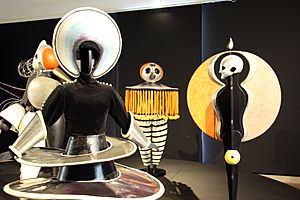Oskar Schlemmer facts for kids
Quick facts for kids
Oskar Schlemmer
|
|
|---|---|

Oskar Schlemmer in a photograph by Hugo Erfurth (1920)
|
|
| Born | 4 September 1888 |
| Died | 13 April 1943 (aged 54) |
| Nationality | German |
| Known for | Painting, sculpture, puppetry, theatre, dance |
| Movement | Bauhaus |
Oskar Schlemmer (born September 4, 1888 – died April 13, 1943) was a German artist. He was a painter, sculptor, designer, and choreographer. He is best known for his connection to the famous Bauhaus school of art and design.
In 1923, he became a master at the Bauhaus theatre workshop. Before that, he worked in the sculpture workshop. His most famous artwork is Triadisches Ballett (Triadic Ballet). In this ballet, actors wore special costumes that made them look like geometric shapes. Schlemmer called it a "party of form and colour."
Contents
Who Was Oskar Schlemmer?
Early Life and Art Training
Oskar Schlemmer was born in September 1888 in Swabia, Germany. He was the youngest of six children. His parents died around 1900. Young Oskar learned to take care of himself early on. By 1903, he was fully independent. He worked as an apprentice in a workshop that made inlay designs. Later, from 1905 to 1909, he learned marquetry, which is similar to inlay.
Oskar Schlemmer studied at the School of Applied Arts in Stuttgart. He won a scholarship to attend the Stuttgart Academy of Fine Art. There, he studied with landscape painters Christian Landenberger and Friedrich von Keller, starting in 1906. In 1910, Schlemmer moved to Berlin. He painted some of his first important works there. He returned to Stuttgart in 1912. He became a master student of the abstract artist Adolf Hölzel. Schlemmer stopped painting in the impressionism style. He started to use cubism in his art.
In 1914, Schlemmer joined the army for World War I. He fought on the Western Front. After being wounded, he worked in a military cartography (map-making) unit. He stayed there until 1918. He then returned to work with Hölzel. The doll-like figures he drew during this time might have been inspired by the wounded soldiers he saw.
Oskar Schlemmer and the Bauhaus School



In 1919, Schlemmer started creating sculptures. He had an exhibition of his work in Berlin. At the same time, he helped improve the art school in Stuttgart. They brought in new teachers and showed modern art. Artists like Paul Klee and Willi Baumeister were involved. After marrying Helena Tutein in 1920, Schlemmer was invited to Weimar. Walter Gropius asked him to join the Bauhaus School. Schlemmer led the mural-painting and sculpture departments. In 1923, he took over the stagecraft workshop.
His ideas were very important and complex. This made him one of the most important teachers at the Bauhaus. However, the political situation in Germany became difficult. In 1929, Schlemmer left the Bauhaus. He took a job at the Art Academy in Breslau.
Schlemmer became famous around the world when his Triadisches Ballett premiered in Stuttgart in 1922. His work at the Bauhaus and his interest in theatre were very important. His art often explored how human figures relate to space. People, usually faceless female figures, were a main subject in his paintings. At Bauhaus, he created a course called "Der Mensch" (The human being). He believed the human form could bring order to the confusing times. After using Cubism for his studies, Schlemmer became interested in how figures interact with space. An example is his work 'Egocentric Space Lines' (1924). Schlemmer's unique shapes can be seen in his sculptures and paintings. He also designed stages for operas and ballets, like Igor Stravinsky's 'Nightingale' and 'Renard' in 1929.
Art During Difficult Times
From 1928 to 1930, Schlemmer painted nine murals for a room in the Folkwang Museum in Essen. After leaving the Bauhaus in 1929, Schlemmer worked at the Academy in Breslau. There, he painted his most famous work, 'Bauhaustreppe' ('Bauhaus Stairway') in 1932. This painting is now in the Museum of Modern Art in New York. He had to leave the Breslau Academy when it closed due to money problems after the Wall Street Crash.
In 1932, he became a professor at the United State School for Fine and Applied Art in Berlin. But in 1933, he was forced to leave because of pressure from the Nazis. The Schlemmers then moved to Eichberg and later to Sehringen. In 1937, his paintings were shown at the "Degenerate Art Exhibition" in Munich. This exhibition showed art that the Nazis did not approve of. The last ten years of his life were spent in a state of "inner emigration." This means he withdrew from public life and focused on his art privately.
During World War II, Schlemmer worked at a paint factory in Wuppertal. Other artists like Willi Baumeister and Georg Muche also worked there. The factory allowed Schlemmer to paint without fear of being bothered. His series of eighteen small, mysterious paintings called "Fensterbilder" ("Window Pictures," 1942) were painted while he looked out his window. He watched his neighbors doing their daily tasks. These were Schlemmer's last works. He died of a heart attack in a hospital in Baden-Baden in 1943.
Oskar Schlemmer's Lasting Impact
Schlemmer's ideas about art were complex. They were even challenging for the modern Bauhaus movement. However, his work was shown widely in Germany and other countries. He did not believe in pure abstract art. Instead, he kept a sense of the human form in his work. He saw human bodies as architectural shapes. He simplified figures into a rhythmic play of curved and flat surfaces. He was fascinated by every movement the body could make. He tried to capture this in his art. Besides his many artworks, Schlemmer's art theories have also been published. A book of his letters and diary entries from 1910 to 1943 is also available.
Schlemmer's diary and private letters to Otto Meyer and Willi Baumeister have given important information. They show what happened at the Bauhaus. They also reveal how the staff and students reacted to the many changes at the school.
The first major show of Schlemmer's work in the United States was held by the Baltimore Museum of Art in 1986.
In 2013, Complex magazine ranked Triadic Ballet as the 23rd best performance art work in history. They wrote that it was a major sign of the Bauhaus movement. It became famous as one of the first examples of multimedia performance. Schlemmer even designed the costumes first, then created the dance around them. On September 4, 2018, Google celebrated his 130th birthday with a special Google Doodle.
Art Sales and Value
In 1998, Schlemmer's painting Idealistic Encounter (1928) was sold for $1.487 million. This happened at Sotheby's in New York.
See also
 In Spanish: Oskar Schlemmer para niños
In Spanish: Oskar Schlemmer para niños


